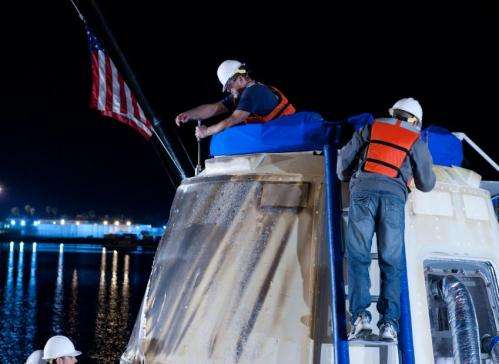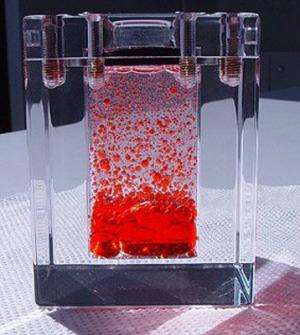SpaceX spacecraft splashdown, starring Space Station science

The return of the SpaceX Dragon brings with it plant samples, data that may impact your facial cream composition and validation of a new way of creating on Earth crystals that are used in our daily electronic devices. This completes the company's fourth contracted resupply mission to the International Space Station. The Dragon carries with it research hardware; samples and data from biology, biotechnology, physical science and human research; and technology development and demonstration studies.
Because a variety of plant studies are ongoing aboard the space station, it's natural that samples from several investigations involving plants are returning aboard the Dragon spacecraft. The Plant Gravity Sensing 1 study examines the cellular process of formation in thale cress, or Arabidopsis thaliana, a small flowering plant related to cabbage. Its genetic makeup is simple and well-understood by the plant biology community. This knowledge offers easy recognition of any changes that occur as a result of microgravity adaptation.
In this study of thale cress, researchers examined the mechanisms of the plant that determine its growth direction up or down—its gravity sensor—in the absence of gravity. The research team analyzed the role of a specific type of protein, MCA1, in the plant's gravity sensor. These types of studies help scientists understand plant growth mechanisms in microgravity to be better able to cultivate plants for food on future spaceflights or possibly on other planets.
This study also helps researchers prove their hypothesis that it may be possible to modify a plant's gravity sensor on Earth. If the gravity sensors of plants could be modified, their ability to withstand heavy winds and rain may improve. This could potentially result in a higher crop output from farms. Furthermore, understanding the cellular processes in plant development may translate to better knowledge of cellular processes in the human body. As a result, medical science research teams may gain a better understanding of mechanisms of diseases affected by gravity, such as osteoporosis and muscle loss.
The second plant study with samples returning to Earth, NanoRacks-Girl Scouts of Hawai'i-Arugula Plant Growth, seeks to determine the impact that various nutrients and microgravity have on the growth and nutritious value of arugula seedlings that sprouted in space. The goal of the study is to develop better ways to grow plants with a high nutritional content in the space environment. If the study samples have a high nutrition value, this may enable NASA and astronauts to produce and consume fresh, healthy food during future space travel.

A team of eight Girl Scouts in Hawai'i conceived this plant study of arugula seedlings, adding experience in research design, decision-making and project management to their repertoire. They came up with this idea to not only contribute to scientific knowledge of growing plants in space but also to examine possibilities to help create sustainable growing practices in Hawai'i. Their goal is that findings from the study of arugula seedlings grown in space may lead to new agricultural production methods that use less fertilizer while producing crops with high nutritional value.
Plants, microbes and animals are often used as model organisms in research both on the ground and in the orbiting laboratory. Model organisms are well-understood, non-human species with characteristics that allow them easily to be maintained, reproduced and studied in a laboratory.
In addition to the plant samples, tissue samples from mice flown to the space station as part of the Rodent Research-1 (CASIS) investigation also will return on the Dragon spacecraft. This study supports ongoing research into how microgravity affects animals, providing information relevant to human spaceflight, discoveries in basic biology and knowledge that may have direct impact toward human health on Earth.
Data from the Fundamental and Applied Studies of Emulsion Stability (FASES) investigation, also returning, will be processed on the ground. The goal is to help determine the physical principles playing a part in stabilizing different emulsions and the compounds that influenced those emulsions while in orbit. Emulsions are mixtures of two or more liquids where one liquid is present in droplet form and distributed throughout the other liquid. Common emulsions on Earth include milk, mayonnaise and paint. For example, milk is an emulsion of fat droplets in a liquefied solution.
Results from FASES may have implications in improving fluid handling processes in space systems that involve emulsions. Researchers and industry scientists can use the study data to understand which compounds work best to stabilize or destabilize an emulsion. On Earth, this could optimize design of applications of emulsions such as paints, lotions and creams and may help create greener, less synthetic products.
Returned samples from a materials science investigation, Growth of Homogeneous Silicon-Germanium (SiGe) Crystals in Microgravity by the TLZ Method (Hicari), will help researchers evaluate a new crystal growth method called the Traveling Liquidous Zone method. The Japan Aerospace Exploration Agency came up with this method to create homogeneous semiconductor alloy crystal growth.
Homogeneous SiGe crystals grown in microgravity provide basic data for growing large, high quality crystals. Scientists may use the Hicari data to grow large, homogeneous alloy crystals on the ground. SiGe crystals may be used in electronic devices and also in other applications to create more efficient solar cells.
And finally, the first Egyptian protein crystal growth study conducted aboard the space station, NanoRacks-Egypt Against Hepatitis C Virus Microgravity Protein Crystal Growth (NanoRacks-EGAHEP), also returns on Dragon. Hepatitis C is a contagious liver disease highly prevalent in Egypt that can be mild, lasting weeks, or serious and become a long-term illness. Researchers use protein crystal growth studies to determine and understand the structure of proteins. This study in microgravity looks at the proteins that make up the hepatitis C virus to understand how the virus replicates. This knowledge may lead to new methods for treatment of viral infections like hepatitis C.
With so many Earth applications anticipated from these investigation results, as well as implications for long-duration spaceflight, the Dragon spacecraft provides an important role in transporting precious research cargo back to Earth.
Provided by NASA





















